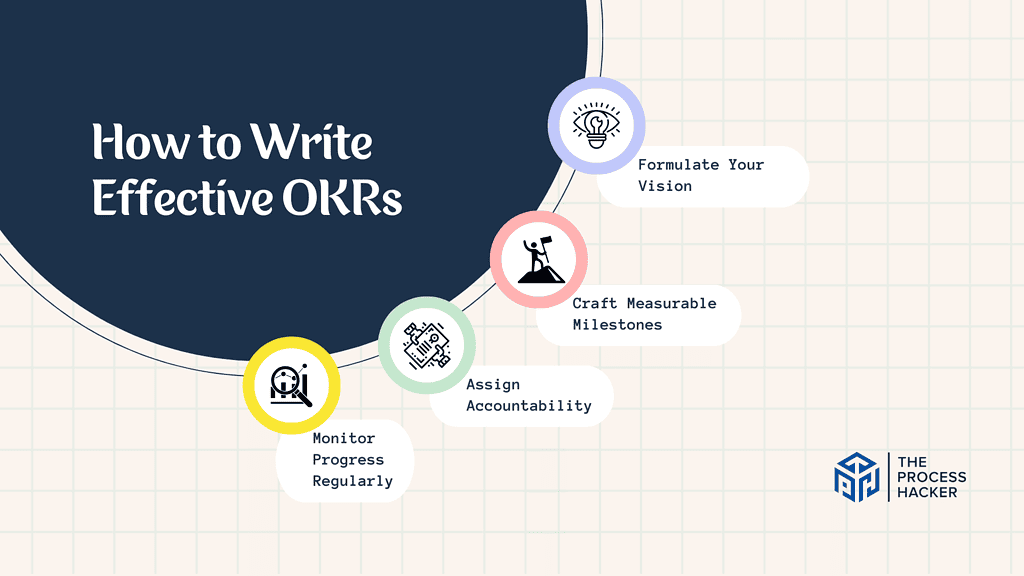How To Write OKRs To Measure Success
Ready to measure success and drive progress in your organization?
Objectives and Key Results (OKRs) help you effectively increase team collaboration, track progress, and get results.
In this Guide on “How To Write OKRs To Measure Success,” you can create objectives that align with your goals, quantify outcomes, and ensure accountability throughout your organization — all while enabling engagement across teams at every level.
Imagine a world where you have real-time visibility into what’s working and not working in terms of performance—a roadmap for sustained long-term growth that leads to model success!
Our guide on “How To Write OKRs” sets up your team for success by guiding users on how to create disciplined structure & cadence around prioritizing efforts within their organizations!
So, let’s get started writing OKRs to measure your organization’s success!
What Are Objectives and Key Results (OKRs)?
Objectives and Key Results (OKRs) are a goal-setting framework used by individuals, teams, and organizations to define measurable goals and track their outcomes.
This approach helps you clearly define what you aim to achieve (the Objective) and how you will measure success (the Key Results). Let’s define the approach’s key elements:
Objectives
When you are writing Objectives, you’re setting your high-level, aspirational goals. These should be significant, concrete, and action-oriented. Think of them as the ‘what’ of your goal-setting – what you want to accomplish.
Your Objectives should be inspiring and challenging yet achievable. They set the direction and provide a clear focus for your efforts.
Key Results
Key Results are the measurable outcomes you’ll use to track your progress toward each Objective. They are specific, time-bound, and quantifiable.
Think of them as the ‘how’ of your goal-setting – how you’ll know you’re making progress and, ultimately, how you’ll know you’ve achieved your Objective.
Good Key Results are often numerical targets, such as percentage increases, growth metrics, or specific milestones. They should be realistic but challenging, ensuring you push yourself or your team to deliver significant results.
Keep In Mind
When you’re setting good OKRs, you’re essentially establishing a clear direction for what you want to achieve (the Objective) and deciding on concrete, quantifiable actions or outcomes (the Key Results) that will signify progress toward that objective.
This framework helps you focus on significant, ambitious goals and encourages you to measure success regarding real outcomes.
For example, if your Objective is to improve client satisfaction, write Key Results that could include increasing client satisfaction survey scores by 20%, reducing customer service response times by 30%, and increasing customer retention rates by 15%.
By defining your goals and success metrics in this way, you create a transparent roadmap for progress, making it easier for you and your team to understand what success looks like and how to achieve it.
Why You Should Implement OKRs In Your Business
You might be wondering why your business needs another framework or system. After all, you already have goals and targets, right? But here’s the thing – it’s not just about setting goals; it’s about how you track and measure them.

This is where Objectives and Key Results (OKRs) come in. They’re a powerful tool used by successful companies like Google and LinkedIn to measure success and drive growth. Here’s a short list of its benefits:
- Measure Progress Toward Your Company Objectives
- Improve Customer Satisfaction
- Hold Your Leadership Team Accountable
Now, you may think your current methods are enough. But consider this: great OKRs help you set clear, measurable objectives and track your progress towards them in real-time. They can help you improve client satisfaction by aligning your team’s efforts with customer needs and expectations.
Most importantly, they hold your leadership team accountable, ensuring everyone works towards the same goals. By implementing great OKRs in your business, you’re not just setting goals – you’re setting yourself up for success.
Measure Progress Toward Your Company Objectives
One of the biggest challenges you might face in running your business is understanding how close or far you are from achieving your objectives. With good OKRs, you can measure this progress accurately and efficiently. Set objectives and write Key Results for specific, measurable tracking steps.
Each key result brings you one step closer to achieving your objective, and by measuring these results, you’ll be able to see exactly how much progress you’re making. This can give you a clear picture of where you stand and what needs to be done to reach your goals. The clarity and direction that OKRs provide can be a game-changer for your business.
Improve Customer Satisfaction
As a business owner, you know that customer satisfaction is paramount. It’s the key to repeat business, positive word of mouth, and your company’s success. But how can you ensure your customers are consistently happy with your products or services? This is where OKRs come into play.
By implementing good OKRs, you can set specific objectives related to client satisfaction, such as reducing response times, improving product quality, or increasing customer service efficiency.
The key results will then provide measurable steps to achieve these objectives. As you track your progress towards these key results, you’ll have a tangible way to see improvements in client satisfaction.
This process will help you identify areas for improvement and motivate your team to strive for better performance. So, if you want to enhance client satisfaction, OKRs could be the tool you need.
Hold Your Leadership Team Accountable
Accountability is a crucial element in any successful team. As a leader, it’s your job to ensure everyone pulls their weight and contributes to the company’s objectives. But how can you effectively hold your leadership team accountable? That’s where OKRs come into the picture.
When you implement OKRs, you set clear, measurable objectives for your team. Each key result is a step toward the objective, and with each step being tracked, there’s no room for ambiguity. You can see who meets their targets and who might need extra support or guidance.
This level of transparency fosters a culture of accountability in your team. It shows you’re serious about achieving your goals and that everyone has a role to play.
So, if you want to ensure your leadership team is truly driving your business forward, implementing OKRs could be the move you need to make.
How to Write Effective OKRs
In your journey to success, setting and achieving goals is paramount. One effective way to do this is by writing OKRs – Objectives and Key Results.

This goal-setting framework allows you to establish ambitious objectives and measurable key results. But how can you write effective OKRs that look good on paper and translate into real-world success? Here’s a unique process tailored just for you.
- Formulate Your Vision
- Craft Measurable Milestones
- Assign Accountability
- Monitor Progress Regularly
Now that you have an overview of the steps involved, let’s delve deeper into the process to understand how you can craft effective OKRs that drive you and your team toward your business goals. Let’s get started!
#1) Formulate Your Vision
The first step in crafting effective OKRs is to “Formulate Your Vision.” This involves setting out your ambitious and inspiring Objective.
Begin by asking yourself, what do you aspire to achieve? This could range from boosting revenue, enhancing customer satisfaction, launching a groundbreaking product, or developing your team’s competencies.
Your objective should be in sync with your company’s mission and vision, but it should also push your boundaries. The aim here is to stretch beyond your comfort zone.
Once you’ve determined your objective, articulate it clearly and concisely. For instance, if your objective is to enhance customer satisfaction, your statement might be: “Elevate customer satisfaction through exceptional service.”
You must clearly express your objective, as this will be the goal you and your team will strive towards. It acts as your guiding star, your ultimate aim. So, take your time with this step, and ensure your objective is something that motivates you and your team to achieve greatness.
#2) Craft Measurable Milestones
Once you’ve formulated your vision, the next step is to “Craft Measurable Milestones.” These are your Key Results – the measurable steps to guide you toward your objective.
Key Results should be quantifiable indicators of progress. How will you know if you’re moving closer to your objective? What tangible evidence will show you’re on the right track?
This could be a percentage increase in sales, a number of new customers acquired, or a specific improvement in product performance.
For each objective, aim to define 3-5 key results. For example, if your objective is to “Elevate customer satisfaction through exceptional service,” your key results might include the following:
- “Increase customer service rating by 20%”
- “Reduce customer complaints by 15%”
- “Achieve a Net Promoter Score of 8 or above.”
Remember, your key results should be challenging but realistic. They should push you and your team to work harder and think creatively, but they should also be achievable with your resources and time.
By setting clear, measurable milestones, you can track your progress and adjust your approach as needed, ensuring you stay on the path to achieving your objective.
#3) Assign Accountability
After crafting measurable milestones, the next step is to “Assign Accountability”. This involves delegating each OKR to a specific team member or a team.
Start by reviewing your OKRs and considering the skills and resources required to achieve each one. Who in your team has the skills, experience, or capacity to take on each key result? You might assign an entire objective to one team or assign individual key results to different team members.
Once you’ve decided who will be responsible for each OKR, it’s crucial that you communicate this clearly. Each team member should understand what they are expected to achieve and why it matters. They should see how their work contributes to the larger objective and aligns with the company’s overall vision.
For example, if one of your key results is to “Increase customer service rating by 20%”, you might assign this to your customer service team. Explain to them why this key result is important, how it fits into the larger objective, and what impact it will have on the company.
Assigning accountability ensures everyone knows their role and responsibilities, creating a sense of ownership and commitment. It also allows you to track progress more effectively, as you can check in with the relevant team or individual to see how things are going. Remember, accountability is key to achieving your objectives.
#4) Monitor Progress Regularly
Once you’ve assigned accountability, your next step is to “Monitor Progress Regularly.” This is crucial in ensuring you write great OKRs that are on track and identify any potential issues early.
To monitor progress effectively, you need to establish a regular review cycle. This might be weekly, bi-weekly, or monthly, depending on the nature of your objectives and key results. Each team or individual should report their progress toward their assigned key results during these review sessions.
These check-ins should focus on whether key results are being met and how they are being achieved. Are there any obstacles hindering progress? Are there any opportunities to accelerate progress? This is an opportunity for problem-solving, brainstorming, and celebrating achievements.
For instance, if one of your key results is to “Increase customer service rating by 20%”, your customer service team might report on the current rating, what strategies they’ve implemented to improve it, and what challenges they’ve encountered.
Monitoring progress regularly keeps everyone focused and engaged, allows for timely adjustments, and ensures you’re moving steadily toward your objectives. It’s not just about tracking success but also about learning and improving along the way.
Key Tips for Writing Effective OKRs
As you go through your journey of writing own OKRs, remember that your objectives should inspire and motivate.
They should paint a clear picture of the future you want to create and serve as a rallying call for your team. Don’t be afraid to aim high – ambitious objectives can drive innovation and encourage your team to think outside the box.
When crafting your key results, remember that they should be specific and measurable. Avoid vague language and opt for concrete numbers or percentages wherever possible. This will make tracking progress easier and determining when a key result has been achieved.
Lastly, never underestimate the power of regular check-ins. Consistent monitoring allows you to stay on top of progress, identify any roadblocks, and make necessary adjustments. This keeps everyone accountable and fosters a culture of transparency and continuous improvement.
Remember, the journey towards achieving your OKRs is just as important as the end result.
Taking it to the Next Level: Read Radical Focus by Christina Wodtke
If you want to enhance your understanding of OKRs and take your goal-setting to the next level, exploring additional resources such as “Radical Focus” by Christina Wodtke is a great next step. This book offers a wealth of insights on implementing OKRs in a way that drives focus, creates alignment, and leads to breakthrough results.
Wodtke’s approach to OKRs goes beyond the basic formula of setting objectives and key results. She delves into the human aspects of goal-setting, emphasizing the importance of team buy-in, effective communication, and continuous learning. Her storytelling approach brings the theory of OKRs to life, providing real-world examples and practical tips to help you navigate common challenges and maximize writing OKRs.
Writing OKRs is an ongoing process of trial and error, learning, and adaptation. Don’t be discouraged if your first set of OKRs isn’t perfect – the key is to learn from your experiences, continually refine your approach, and stay committed to your goals. With time, practice, and the right resources, you’ll become adept at writing effective OKRs that truly drive success.
Alternatives to OKRs: Management By Objectives (MBO)
If you’re exploring alternatives to writing OKRs, one popular method you might consider is Management by Objectives (MBO). Organizations have employed this strategy for decades and offer a structured planning and evaluation approach.
In MBO, managers and employees work together to set, plan, and monitor every employee net promoter score and objectives for a specific time period. These objectives are often linked to the organization’s overall goals and strategy.
The MBO process encourages participation and commitment from all levels of the organization, fostering a sense of ownership and alignment.
Remember, the best method between OKRs and MBO for your organization depends on your specific needs, goals, and team dynamics. It’s worth exploring different approaches to find the one that suits you best.
Final Thoughts on OKRs
OKRs are powerful for setting, tracking, and achieving your goals. They provide clear direction, foster alignment within the team, and help you track progress toward your objectives. Whether a small startup or a large organization, OKRs can be pivotal to your success.
Just like any method, the effectiveness of OKRs depends largely on your execution. It’s about setting ambitious goals and regularly reviewing no matter how many key results, learning from your experiences, and making necessary adjustments.
I hope this tutorial has provided you with a solid understanding of how to write OKRs and some alternatives if you find they aren’t a perfect fit for your team. As an experienced professional in strategic planning and performance management, I’ve seen first-hand how these methods can substantially improve efficiency, productivity, and overall performance.
Your journey to mastering OKRs may not be easy, but it will be worth it. So, take the leap, start writing your OKRs, and watch as they bring clarity and focus to your path to success.







